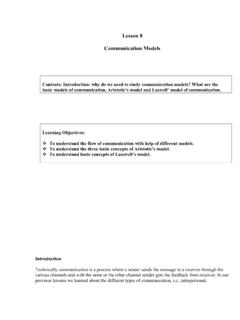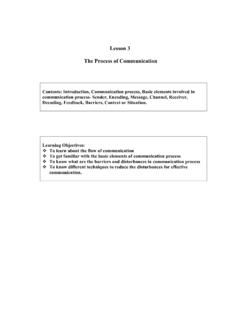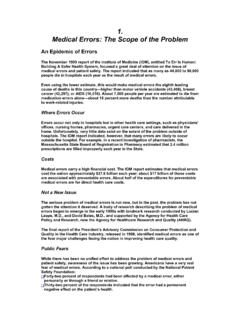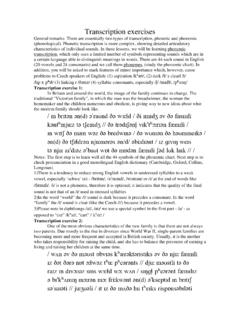Transcription of Lithium Batteries and Cathode Materials
1 Lithium Batteries and Cathode MaterialsM. Stanley Whittingham*Department of Chemistry and Materials Science, State University of New York, Binghamton, New York 13902-6000 Received June 16, 2004 Contents1. Introduction42712. Origins of the Lithium Early Molten Salt Systems at Argonne NationalLaboratory and General Concept of Mixed Early Intercalation Concept42743. 1972 1980: Birth of the Rechargeable Intercalation in the Layered Trichalcogenides and Related Movement into Layered High-Valent Oxides of Vanadium Mixed-Valent Oxides of VanadiumsV6O13and Double-Sheet Structures: Xerogels, -Vanadium Oxides, and Nanotubes42784. 1980 1990: Era of Layered Oxides and FirstLarge Early Studies of Layered Lithium Cobalt Oxide, Lithium Nickel Oxide, LiNiO242815. 1990 Present: Second-Generation Other Layered Mixed Nickel Cobalt Dioxide, Lithium Manganese Dioxide, Mixed Manganese Cobalt Dioxide, Mixed Nickel Manganese Dioxide,LiNi1-yMnyO2sMultielectron Mixed Nickel Manganese Cobalt Dioxide, Lithium -Rich Mixed-Metal Dioxides,Li1+ Iron Compounds Including Oxides Olivine Other Iron Phosphate Vanadium Phosphate Phases42966.
2 Conclusions and What Does the Future Hold42977. Abbreviations and Specialized Terms42978. Acknowledgments42979. References42971. IntroductionIn the previous paper Ralph Brodd and MartinWinter described the different kinds of Batteries andfuel cells. In this paper I will describe lithiumbatteries in more detail, building an overall founda-tion for the papers that follow which describe specificcomponents in some depth and usually with anemphasis on the Materials behavior. The lithiumbattery industry is undergoing rapid expansion, nowrepresenting the largest segment of the portablebattery industry and dominating the computer, cellphone, and camera power source industry. However,the present secondary Batteries use expensive com-ponents, which are not in sufficient supply to allowthe industry to grow at the same rate in the nextdecade. Moreover, the safety of the system is ques-tionable for the large-scale Batteries needed forhybrid electric vehicles (HEV).
3 Another battery needis for a high-power system that can be used for powertools, where only the environmentally hazardous Ni/Cd battery presently meets the battery is a transducer that converts chemicalenergy into electrical energy and vice versa. Itcontains an anode, a Cathode , and an electrolyte. Theanode, in the case of a Lithium battery, is the sourceof Lithium ions. The Cathode is the sink for thelithium ions and is chosen to optimize a number ofparameters, discussed below. The electrolyte providesfor the separation of ionic transport and electronictransport, and in a perfect battery the Lithium iontransport number will be unity in the electrolyte. Thecell potential is determined by the difference betweenthe chemical potential of the Lithium in the anode andcathode, G) noted above, the Lithium ions flow through theelectrolyte whereas the electrons generated from thereaction, Li)Li++e-, go through the externalcircuit to do work.
4 Thus, the electrode system mustallow for the flow of both Lithium ions and is, it must be both a good ionic conductor andan electronic conductor. As discussed below, manyelectrochemically active Materials are not good elec-tronic conductors, so it is necessary to add anelectronically conductive material such as carbon* To whom correspondence should be addressed. Phone and fax:(607) 777-4623. E-mail: ,104,4271 CCC: $ 2004 American Chemical SocietyPublished on Web 09/14/2004black. To physically hold the electrode together, abinder is also added. In these cases the electrochemi-cal reaction can only occur at those points where theactive material, the conductive diluent, and electro-lyte meet. Thus, most electrodes are complex review will be mainly concerned with thecathode. The anode, the source of Lithium , is normallya graphitic carbon and will be discussed in detail byRachid Yazami in a future issue.
5 The electrolytesolution commonly comprises a Lithium salt dissolvedin a mixture of organic solvents, examples includeLiPF6or LiBOB (the BOB is the anion with the boroncoordinated by two oxalate groups) in an ethylenecarbonate/dimethyl carbonate solvent; Kang Xu dis-cusses electrolytes later in this issue. Althoughorganic polymers containing Lithium ions have beenstudied for several decades as possible electrolytes,their conductivity is still too low, and so they are onlyused when a liquid is added to give a plasticizedstate. In a few cases, solid electrolytes have been usedfor a few specialized applications such as for oil welllogging where elevated temperatures are the ions flow through the electrolyte, theanode and Cathode must be physically separated toprevent an electrical short. This is accomplished byusing a porous separator material, which allowswetting by the electrolyte and the flow of Lithium ionsthrough it.
6 P. Aurora discusses these Materials most consumer devices, energy storage is key:operating time is key, so the more the better, as, forexample, in cell phones, laptop computers, and MP3players such as the iPOD. For some larger applica-tions, such as the battery in hybrid electric vehicles(HEV), power is most important as the materialsmust be able to charge sufficiently fast to takeadvantage of regenerative braking; otherwise, muchof the gas savings are lost. The all-electric consumerelectric vehicle is probably dead, at least in theUnited States, because of its limited range and theuser s desire for instant heating and air-conditioningamong other high-power consumption devices. How-ever, there is still much interest in Asia, particularlyfor scooters as well as for all electric key requirements for a material to be success-fully used as a Cathode in a rechargeable lithiumbattery are as follows.
7 (1) The material contain a readily reducible/oxidizable ion, for example a transition metal.(2) The material react with Lithium in a revers-ible manner.(a) This dictates an intercalation-type reac-tion in which the host structure essentiallydoes not change as Lithium is added.(3) The material react with Lithium with a highfree energy of reaction.(a) High capacity, preferably at least onelithium per transition metal.(b) High voltage, preferably around4V(aslimited by stability of electrolyte).(c) This leads to a high-energy storage.(4) The material react with Lithium very rapidlyboth on insertion and removal.(a) This leads to high power density, whichis needed to replace the Ni/Cd battery or forbatteries that can be recharged using HEVregenerative braking.(5) The material be a good electronic conductor,preferably a metal.(a) This allows for the easy addition or re-moval of electrons during the electrochemi-cal reaction.
8 (b) This allows for reaction at all contactpoints between the Cathode active materialand the electrolyte rather than at ternarycontact points between the Cathode activematerial, the electrolyte, and the electronicconductor (such as carbon black).(c) This minimizes the need for inactiveconductive diluents, which take away fromthe overall energy density.(6) The material be stable, , not changestructure or otherwise degrade, to overdis-charge and overcharge.(7) The material be low cost.(8) The material be environmentally all of the research and commercializationof Cathode Materials has centered on two classes ofmaterials. The first contains layered compounds withan anion close-packed or almost close-packed latticein which alternate layers between the anion sheetsare occupied by a redox-active transition metal andlithium then inserts itself into the essentially emptyremaining layers.
9 This structure is depicted in Figure1. This group is exemplified by first LiTiS2, followedM. Stanley Whittingham was born in Nottingham, England, and receivedhis and degrees in Chemistry from Oxford University workingwith Peter Dickens. In 1968 he went to Professor Robert A. Hugginsresearch group in the Materials Science Department at Stanford Universityas a Postdoctoral Research Associate to study fast-ion transport in 1972 he joined Exxon Research and Engineering Company to initiatea program in alternative energy production and storage. After 16 years inindustry he joined the Binghamton campus of the State University of NewYork as Professor of Chemistry to initiate an academic program in MaterialsChemistry. Presently he is also Professor of Materials Science and Directorof the Materials Science Program and Institute for Materials was awarded the Young Author Award of the Electrochemical Societyin 1971, a JSPS Fellowship in the Physics Department of the Universityof Tokyo in 1993, and the Battery Research Award of the ElectrochemicalSociety in 2002 and was elected a Fellow of the Electrochemical Societyin 2004.
10 He was Principal Editor of the journalSolid State Ionicsfor 20years. His recent work focuses on the synthesis and characterization ofnovel microporous and nano-oxides and phosphates for possibleelectrochemical and sensor Reviews, 2004, Vol. 104, No. 10 Whittinghamby LiCoO2, LiNi1-yCoyO2, and today spinels may be considered as a special casewhere the transition-metal cations are ordered in allthe layers. The Materials in the second group havemore open structures, like many of the vanadiumoxides, the tunnel compounds of manganese dioxide,and most recently the transition-metal phosphates,such as the olivine LiFePO4. The first group, becauseof their more compact lattices, will have an inherentadvantage in energy stored per unit of volume, butsome in the second group, such as LiFePO4, arepotentially much lower cost. The following discussionwill center predominantly on these two classes Origins of the Lithium Early ConceptsSome of the earliest concepts came from Japan,where Matsuchita developed1the Li/(CF)nbatterythat was used, for example, in fishing floats.









